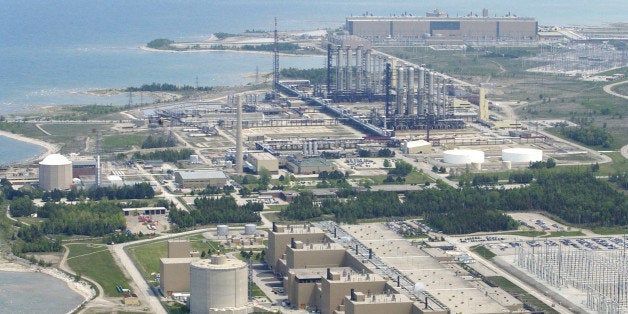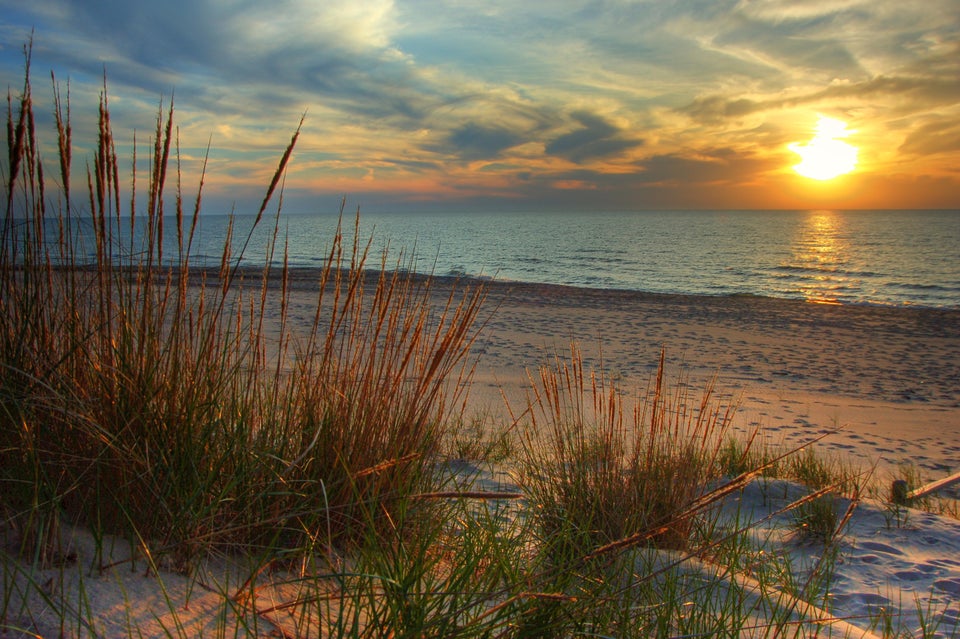
A proposed Canadian nuclear waste site near the shores of Lake Huron is facing mounting criticism from Michigan lawmakers who say it's dangerous and called on the federal government to intervene.
Ontario Power Generation (OPG), which supplies electricity in the Canadian province, has long had plans to construct and operate a deep geologic repository (DGR) for nuclear waste at the Bruce Nuclear Power Plant near Kincardine. The DGR would be just under a half mile underground and store nearly 53 million gallons of "low and intermediate-level" radioactive nuclear waste on a site three quarters of a mile from Lake Huron, part of the Great Lakes system that provides drinking water for millions of people in two countries.
“Building a nuclear waste dump less than a mile from one of the largest freshwater sources in the world is a reckless act that should be universally opposed," Michigan Rep. Dan Lauwers (R-Brockway Township) said in a statement Monday.
 In this Nov. 1, 2013 photo is Lake Huron just beyond a fence enclosing a section of the Bruce Power nuclear complex near Kincardine in the Canadian province of Ontario. (AP Photo/John Flesher)
In this Nov. 1, 2013 photo is Lake Huron just beyond a fence enclosing a section of the Bruce Power nuclear complex near Kincardine in the Canadian province of Ontario. (AP Photo/John Flesher)
Michigan residents and an assortment of bipartisan lawmakers have repeatedly objected to the proposal. On Monday, several lawmakers from Michigan's thumb region, which borders Lake Huron, announced a legislation package that would ban importing nuclear waste into the state and include a joint resolution calling on President Barack Obama, Secretary of State John Kerry and Congress to act on behalf of the Great Lakes.
Last year, U.S. Senators Carl Levin and Debbie Stabenow, both Democrats from Michigan, called on the State Department to have the International Joint Commission (an agency created to settle disputes regarding the Great Lakes) intervene. Other members of the Michigan State Legislature and U.S. Congress have also protested the plan, along with environmental and business groups.
The DGR would be the first of its kind in North America and could potentially pave the way for other nuclear waste storage facilities underground, according to the Associated Press. It would store low-level waste, which "consists of minimally radioactive materials such as mop heads, rags, paper towels, floor sweepings and protective clothing used in nuclear stations during routine operation and maintenance," according to OPG, and intermediate-level waste, which they describe as "resins and filters, and used reactor components." The DGR would not store spent fuel.
 Bruce Nuclear Plant on Lake Huron. (Photo by Dick Loek/Toronto Star via Getty Images)
Bruce Nuclear Plant on Lake Huron. (Photo by Dick Loek/Toronto Star via Getty Images)
OPG has said a team of experts have reviewed their plans and found that the DGR would be safe, in no danger of contaminating Lake Huron and tightly encased by the surrounding 450-million-year-old rocks. According to the AP, the plan has wide support among residents of Kincardine and other nearby communities. "We don't have the knee-jerk reaction when someone says 'nuclear' that other people do," Joanne Robbins, general manager of the chamber of commerce in nearby Saugeen Shores, told the AP. "We grew up with it."
Critics however, have refuted some of OPG's claims and wondered why it was necessary to risk putting a facility so near to the lake.
The plan "poses a serious threat to people, fish, wildlife and the lakes themselves," Andy Buchsbaum, regional executive director for the National Wildlife Federation’s Great Lakes Regional Center, said in a statement Monday. For example, long-term exposure to radiation can cause cancer as well as DNA mutations.
 This Nov. 1, 2013 photo shows rows of chambers holding intermediate-level radioactive waste in shallow pits at the Bruce Power nuclear complex near Kincardine, Ontario. (AP Photo/John Flesher)
This Nov. 1, 2013 photo shows rows of chambers holding intermediate-level radioactive waste in shallow pits at the Bruce Power nuclear complex near Kincardine, Ontario. (AP Photo/John Flesher)
Dr. Frank R. Greening , who previously worked as a scientist at OPG, said the radioactivity of the materials to be buried has been "seriously underestimated." In a letter submitted in January to the Canadian federal panel reviewing the site, Greening wrote that some of the materials are 100 times more radioactive than initially stated -- and some are 600 times more radioactive. An OPG spokesman told the Toronto Star that while Greening's numbers may be valid, they don't change findings that the facility will be safe. Greening acknowledged that possibility, but called their overall procedures into question in an interview with Michigan Radio
"My first feeling was, look, you messed up the most basic first step in establishing the safety of this facility, namely, how much radioactive waste they're going to be putting in the ground, you admit you got that wrong, but now you're telling me that everything else is okay," Greening told Michigan Radio. "You can't just fluff off this error as one error. It raises too many questions about all your other numbers. And I'm sorry, I now have lost faith in what you're doing."
After Greening shared his findings, the federal review panel ordered OPG to resubmit its safety assessment. According to the Detroit News, a Canadian review panel has several months to submit a report about the proposal, and then the Ministry of the Environment has four months to approve or reject it.

